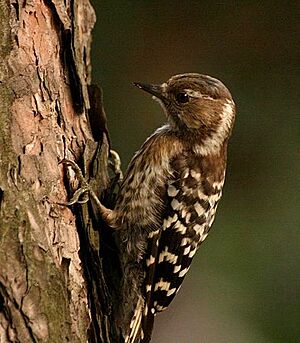Japanese pygmy woodpecker facts for kids
Quick facts for kids Japanese pygmy woodpecker |
|
|---|---|
 |
|
| Conservation status | |
| Scientific classification | |
| Genus: |
Yungipicus
|
| Species: |
kizuki
|
| Synonyms | |
|
|
The Japanese pygmy woodpecker (Yungipicus kizuki) is a small bird that belongs to the woodpecker family. You can find it in forests across Russia, China, Korea, and Japan. It likes both forests with cone-bearing trees (coniferous) and forests with trees that lose their leaves (deciduous). Scientists consider this woodpecker a "least-concern species," which means it's not currently in danger of disappearing.
Contents
What's in a Name? (Taxonomy)
This special bird was first described by a scientist named Temminck in 1836. Like many animals, the Japanese pygmy woodpecker has a scientific name, Yungipicus kizuki. Scientists sometimes group animals in different ways. This woodpecker has also been placed in other groups, like Dendrocopos or Picoides, before finding its current scientific home. There are also different types, or subspecies, of this woodpecker found in various places.
What Does It Look Like?
The Japanese pygmy woodpecker is a small bird, only about 13 to 15 centimeters (about 5 to 6 inches) long. Its head is grey-brown. It has a white stripe above its eye that goes down to its neck and chest. Its cheeks are brown, and it has white and grey-brown stripes on its face.
Its chin and throat are white. The back of its neck and its back are dark brown with white stripes. Its wings are brownish-black with white stripes too. The chest can look a bit brownish, and its belly has different streaks. Its tail is blackish with white stripes on the outer feathers.
This woodpecker has chestnut-colored eyes, a blackish beak, and grey legs. You can tell the boys (males) from the girls (females) because the male has a small red mark on the side of his neck, but the female does not. Female woodpeckers also have slightly longer beaks, wings, and tails than males. Young birds often have streaks on their throats. Birds from the northern parts of their home range are usually bigger and lighter in color than those from the south.
Where Does It Live?
This woodpecker lives in several parts of Asia. You can find it in Korea, northeastern China, southeastern Siberia, an island called Sakhalin, and all over Japan, including the Ryukyu Islands. It can live in places up to 2,100 meters (about 6,900 feet) high.
It likes many different kinds of forests, including those in lowlands, uplands, and near rivers. You might even spot them in parks and gardens!
Behaviour and Life Cycle
Japanese pygmy woodpeckers often hang out in pairs or in groups with other types of birds. They search on trees for their food. They love to eat small creatures like spiders, caterpillars, ants, and aphids. They also enjoy berries.
These woodpeckers make high-pitched calls, like "tsi-tsi-tsi" or "khit" and "kzz" sounds. They also "drum" on trees, but their drumming is usually quick and not very loud.
When it's time to have babies, breeding starts in March in southern Japan and later in May in northern Japan. The parents dig a hole in a dead tree branch to make a nest. The female lays about five to seven white eggs. Each egg is about 19 mm by 15 mm (about 0.75 by 0.6 inches). The parents take turns sitting on the eggs for 12 to 14 days to keep them warm. After the eggs hatch, the young birds stay in the nest for about three weeks before they are ready to fly out on their own.
Status
The Japanese pygmy woodpecker is doing well! It lives in a very large area, and there are many of them. Because of this, the International Union for Conservation of Nature (IUCN) says it is a "least-concern species." This means scientists are not worried about it becoming endangered or disappearing anytime soon.



